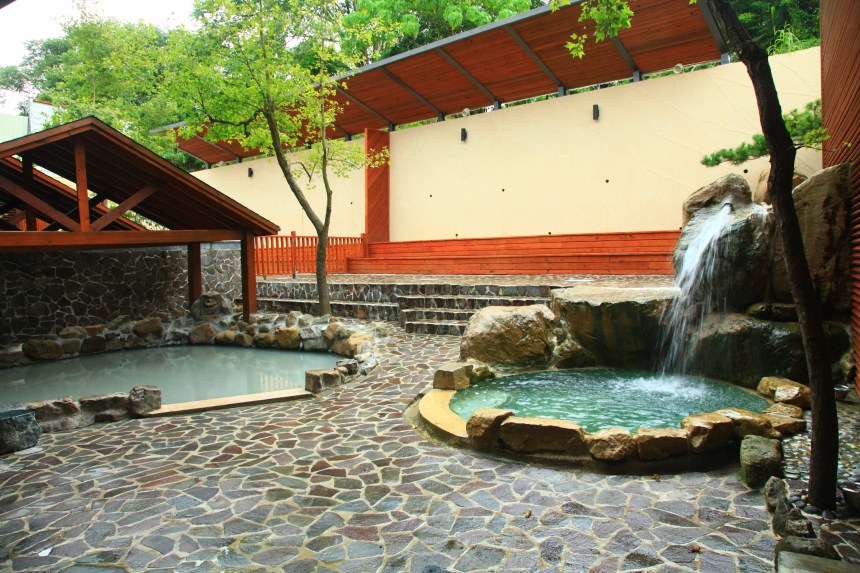Taiwan’s oldest city and urban area, Tainan, located in the country’s southwest, is a destination known for its many temples, sweet local food and culture. However, did you know that it has a variety of water-based attractions that tourists would be foolish to miss out on? From unique hot springs to stunning seaside salt fields, here are three water-related places to visit during your trip to Tainan.
Guanziling Hot Springs

The Guanziling area at the peak of Tainan City’s Zhentou Mountain is renowned for its hot springs. Unique to the area are mud hot springs, sometimes known as black springs due to their grey, dark waters. Rich in minerals, the spring water gets its color from its high levels of naturally occurring sediment consisting of sodium, magnesium and potassium. While being relaxing and good for your skin, it is also said that mud springs are capable of relieving bathers’ muscle and joint pain due to their anti-inflammatory properties. (Read more: 5 ways to experience Tainan, Taiwan’s Ancient Capital)
The mud springs may be Guanziling’s main attraction, but there are other reasons to stop off in the area during your trip to Tainan. A must-visit spot is the centuries old Huoshan Biyun Temple (火山碧雲寺). While its architecture is inspired by both Japanese and southern Chinese styles, its artworks, ceramics and mosaic patterns are more of a nod towards a local aesthetic. The name Huoshan comes from the Mandarin word for volcano due to the area’s abundance of underground natural gas reserves. In fact, the temple’s incense lighter is fueled by natural gas and, as a result, the flame has been lit for hundreds of years – no other temple in Taiwan has such a lighter.

Also, be sure to check out the rice cave next to the temple. A limestone structure, legend has it that rice used to pour out of the cave and was in such abundance that it was enough to feed all of the monks at the temple. Unfortunately, one monk was said to get too greedy and tried to dig into the cave to find more rice. Since that day, no more rice has been produced by the cave.
Jing Zai Jiao Salt Fields

The Beimen region’s first salt fields, Jing Zai Jiao’s flats are said to be the oldest remains of paved salt fields in existence. Nowadays a scenic spot rather than the home to any salt production industry, the fields are packed with tourists who’ve come to admire mosaic-like artworks made from salt tiles, along with one of the most stunning sunsets Taiwan has to offer. Coming to an end in 2002, Jing Zai Jiao was home to a thriving salt production industry for 338 years, but rising labor costs made it unsustainable. Thankfully, the area has been preserved. The salt fields are situated by the sea and the water’s edge is another photogenic spot, particularly on an evening when the sea birds are darting around above the ocean’s surface. (You might also like: Exploring Tainan’s natural side and a brief trip to Hell)

Wushantou Reservoir
Built in the 1920s during Japanese rule, Wushantou Dam controls the flow of water and reduces the sediment flowing into Wushantou Reservoir. It was designed by Yoichi Hatta, a Japanese engineer who served as a technician of the Taiwanese government – his statue and tomb can be visited at the site of the reservoir. There is also an interesting structure near the dam that somewhat resembles Beijing’s Temple of Heaven, which is a must-see for any fans of Chinese-style architecture.

Wushantou Reservoir irrigates more than 150,000 of land and is now connected to Zengwen Reservoir up in the Zengwen River, providing hydroelectric power and water to Tainan and the surrounding area. A highlight of any trip to Wushantou is a lake cruise, while the area is also popular for camping, cycling, horse riding, barbecuing and canoeing. Scenic spots around the reservoir area also include Sanjiaobi Park, Jhongjheng Park and Tiantan.

Be sure to check out the visitor center nearby the Yoichi Hatta statue, where you can find all the details you need about the local area as well as eat some tasty local food at their restaurant.













